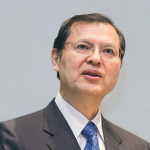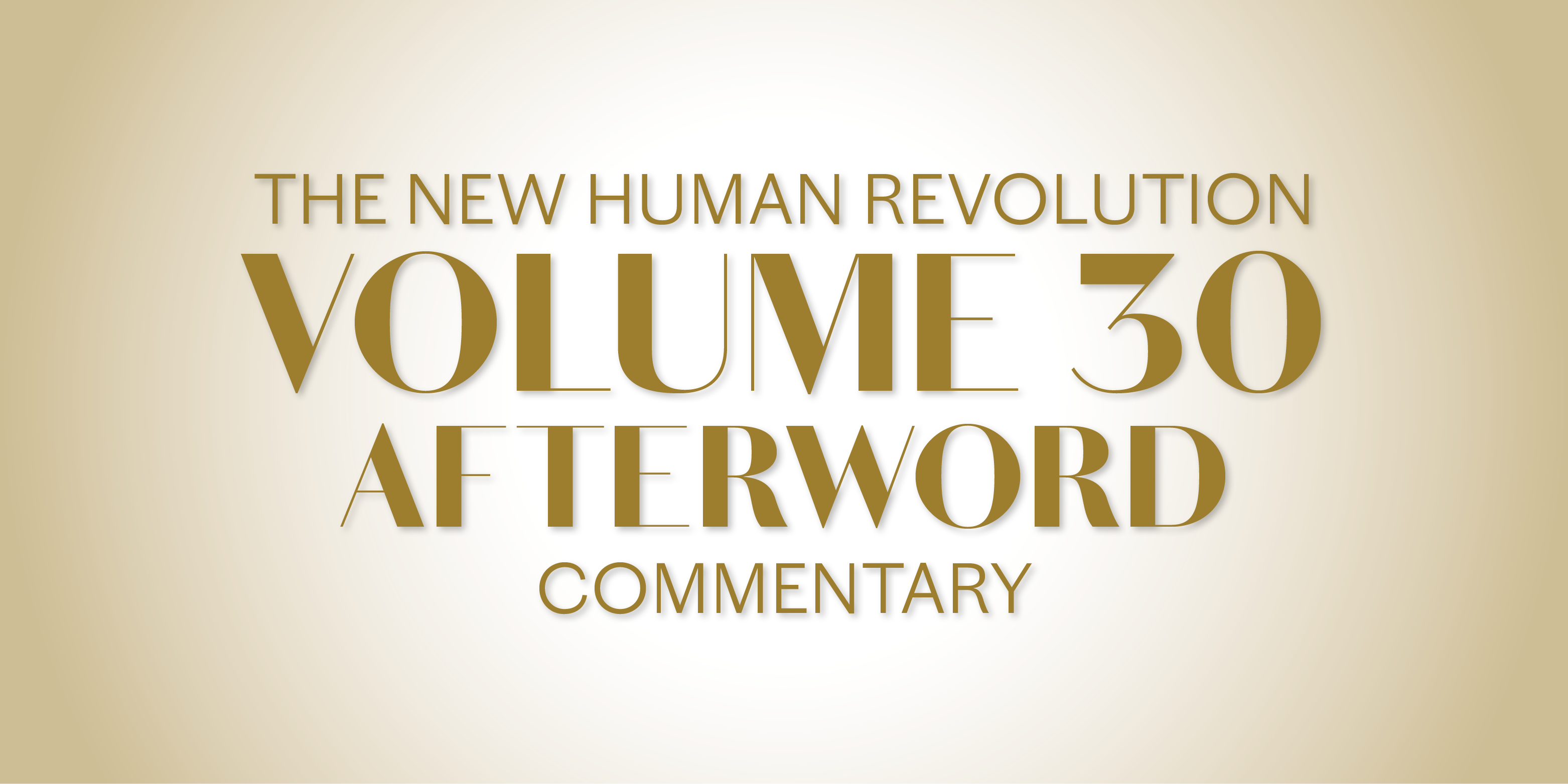 Ikeda Sensei began writing The New Human Revolution 28 years ago, on August 6, 1993, and completed it three years ago on the same date in 2018. He has described this 25-year battle to finish the series within his lifetime as an “intense and unremitting struggle,”[1] an achievement we can surely call historic.
Ikeda Sensei began writing The New Human Revolution 28 years ago, on August 6, 1993, and completed it three years ago on the same date in 2018. He has described this 25-year battle to finish the series within his lifetime as an “intense and unremitting struggle,”[1] an achievement we can surely call historic.
August 6 is the anniversary of the atomic bombing of Hiroshima [in 1945], and September 8 [when the final installment of the novel was published in the Seikyo Shimbun] is the anniversary of second Soka Gakkai President Josei Toda’s Declaration for the Abolition of Nuclear Weapons [in 1957]. Sensei chose these specific dates to start and conclude the novel as an expression of his commitment to transmit and leave an eternal record of the vow he inherited from his mentor—to abolish these weapons and ensure the tragedy of their use is never again repeated—for future generations.
From 2010 onward, the central focus of Sensei’s activities became the continuation of The New Human Revolution. I believe this was made possible thanks to the warm support and prayers of all the members around the world who have drawn sustenance and encouragement from the novel. From this perspective, the completion of The New Human Revolution is truly a victory of the shared struggle of the mentor and disciples of Soka in the 21st century.
The 30th and final volume concludes with the following words:
In his mind’s eye, Shin’ichi had an uplifting vision of the youth of Soka as majestic young eagles bathed in the dawning light of the third millennium. He saw them soaring, in an unending stream, into the vast skies of the world.[2]
These words succinctly capture our mentor’s thoughts as he approached the end of the novel. They express his absolute conviction that youthful successors will continue to emerge like the breaking dawn to bring forth an age of peaceful coexistence.
In this final essay commenting on The New Human Revolution, I would like to reconfirm some of the major themes embodied within all 30 volumes.
One is the Buddhist concept of “transforming karma into mission.” As stated in the afterword: “Karma and mission are two sides of the same coin, and our karma directly becomes our unique and noble mission.”[3]
Another theme is the true nature of devilish functions and “evil friends” in Buddhism that attempt to obstruct the advancement of kosen-rufu. We discover throughout the series that the crucial requirement for truth and justice to prevail in the process of carrying out kosen-rufu—a ceaseless struggle between the Buddha and devilish functions—is the extent to which we can develop committed faith. In the “Cheers of Victory” chapter of volume 30, we find:
By being ready for anything, rising to face major obstacles and persecution head-on, you will develop and strengthen your faith and be able to transform your karma.[4]
As detailed in the novel, I believe the driving force in enabling the Soka Gakkai to surmount the multitude of challenges it faced was Shin’ichi Yamamoto’s committed faith. In this sense, engaging in a shared struggle with our mentor entails forging such a committed, resolute faith, with which we are ready to take on anything.
A New Guide for Humanity
Ikeda Sensei penned the afterword on September 8, 2018, the date that the final installment was published in the Seikyo Shimbun. In it, he sheds light on the conditions that led to his writing of The Human Revolution and The New Human Revolution, his motivation in doing so and what their completion signifies.
The Human Revolution describes the drama of how “a single individual,” President Toda, rose to the challenge of achieving “a change in the destiny of a nation”[5] and how he and his disciples went on to rebuild the Soka Gakkai. The New Human Revolution, on the other hand, chronicles the efforts made by Shin’ichi and his disciples to create a “change in the destiny of all humankind” through their shared struggle for worldwide kosen-rufu.
Just as this principle [of “voluntarily assuming the appropriate karma”] explains, we have chosen, in accord with our vow as bodhisattvas, to be born into the evil age of the Latter Day of the Law with all sorts of destinies, or karma—illness, financial hardship, family discord, loneliness, low self-esteem and the list goes on—to help guide others to enlightenment.[6]
As this passage from the afterword clarifies, everyone has a unique mission to fulfill. We are all Bodhisattvas of the Earth who are “lead players and stars in a glorious drama … of … transforming suffering into joy.”[7] It continues: “Without human revolution, there can be no true personal happiness, social prosperity or lasting world peace.”[8]
Our personal dramas of transforming karma can indeed serve as sources of courage and hope for those around us and in society. As our mentor declares, the philosophy and our actual proof of human revolution grounded in Nichiren Buddhism are “certain to become a new guide for humanity as we set forth into this third millennium.”[9]
An Inner Dialogue With Our Mentor
Over the past three years or so, it has been a privilege to contribute essays commenting on The New Human Revolution. Much more than simply chronicling the history of the Soka Gakkai, the novel also clarifies the unchanging principles of kosen-rufu; so, with every commentary, I have earnestly explored how best to highlight their relevance in light of our current activities.
As I reread each volume, I found myself more deeply engraving in my heart the significance of the novel, which I’ve summarized as follows: 1) It can be considered a textbook of faith from which to learn the spirit of Soka. 2) It is a text through which we can engage in an inner dialogue with our mentor. 3) It is a record of our mentor’s vow entrusted to his disciples.
As explained in the afterword, The Human Revolution and The New Human Revolution represent the “day-to-day record, or chronicle, of the Soka Gakkai’s efforts for kosen-rufu.”[10] They embody “the true history of the Soka Gakkai spirit”[11] and can be regarded as a “textbook of faith” through which we can study and cultivate the Soka Gakkai spirit.
In addition, Sensei says how he poured his heart into writing the novel, calling to mind his precious fellow members as he did so:
I tapped the deepest recesses of my being to write my tale, as if I were sending a letter of encouragement to each one of them. At the same time, I was also engaging in an inner dialogue with my mentor as I wrote.[12]
For us, too, each page of the novel is an opportunity to open the door to an inner dialogue with our mentor. Sensei also writes:
I wanted to leave an eternal record of my vow as a disciple to carry on the spirit and ideals of the first two Soka Gakkai presidents and change the direction of history from an age of war to an age of peace.[13]
Hence, it can also be regarded as a record of our mentor’s vow that he has, in turn, entrusted to his disciples.
Sensei concludes the afterword by sharing his hope that the Soka Gakkai members will make the completion of The New Human Revolution a “fresh starting point.”[14] This is the time for each of us to take the grand stage of kosen-rufu and create our own brilliant history of human revolution.
“I am Shin’ichi Yamamoto!” With this awareness, and setting our sights on the fifth and tenth anniversaries of the completion of the novel, let us advance along our journey of mentor and disciple to realize the great vow for kosen-rufu and continue weaving that “magnificent tapestry of human victory”[15] in our lives.
Translated from the August 6, 2021, Seikyo Shimbun, the Soka Gakkai’s daily newspaper.
This concludes the series “The Brilliant Path of Worldwide Kosen-rufu: Learning from The New Human Revolution.”
Read the afterword in full here.
Key Passages
To realize the grand ideal of peace, we must rally the passion and power of youth. (The New Human Revolution, vol. 30, p. 620)
■ ■ ■
The path of exchange, once opened, must be traversed repeatedly to secure and widen it. (NHR-30, 641)
■ ■ ■
The road ahead in the coming new era of kosen-rufu is bound to be filled with trials and challenges. We cannot obtain victory or make brilliant achievements unless we are wise and determined. (NHR-30, 740)
■ ■ ■
The aim of Nichiren Buddhism … is to relieve people’s suffering. This cannot be done through ideas alone. It requires real wisdom and concrete action. From our perspective, this means “substituting faith for wisdom,” that is, using our Buddhist practice to tap the “wisdom of the Buddha” within our lives. (NHR-30, 782)
■ ■ ■
The greatest mission and responsibility of people of faith today is to strengthen their commitment to building a world free of the scourge of war and bring people together based on the shared goal of realizing peace and happiness for all humankind. (NHR-30, 797)
■ ■ ■
Finding joy, pleasure and hope in the growth of youth who will shoulder the next generation—in the victory of one’s disciples—is the heart of the mentor. Such is the nature of the mentor-disciple bond. (NHR-30, 806–07)
References
You are reading {{ meterCount }} of {{ meterMax }} free premium articles

